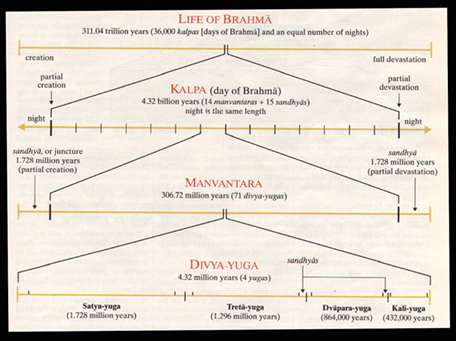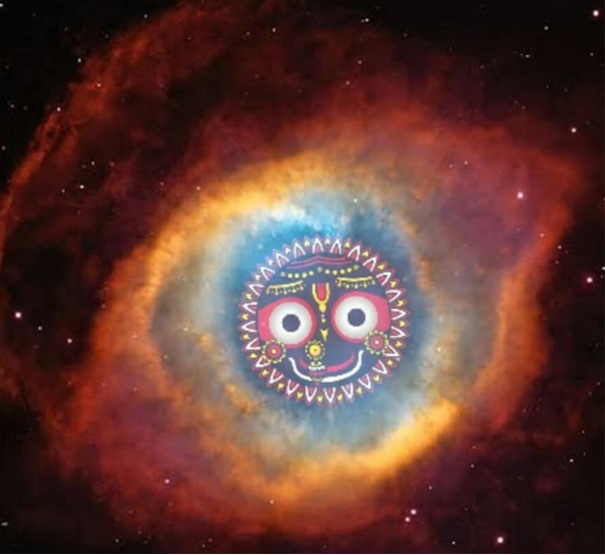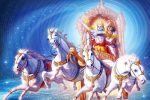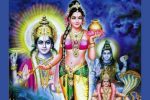NAME 91
Saṁvastsaraḥ संवस्त्सरः
Saṁvastsara refers to a solar year. Sun’s movement from Aries to Pisces, comprising of twelve lunar moths is known as Saṁvastsara. Previous nāma said that He represents twenty four hours of a day and this nāma says that He represents a solar year.
Typically speaking, these two nāma-s say that He is both tiny and large part of time. This goes well with the concept that Brahman is smaller than the smallest and bigger than the biggest. Samvatsarah – He is Time.
There are two meanings for this Nama:
1. He who lives for the upliftment of His devotees.
This meaning is derived from the root vas – to live. Samuddharanaaya samvasati iti samvatsarah.
2. That Bhagavan is Time itself.
Samvatsara means a year or a unit of time. Rightly ‘Kaalaatmanaa Sthito Vishnuh Samvatsra ityuktah – Bhagavan Vishnu who epitomises Time is spoken of as Time itself.’
In the Bhagavad Gita Chapter 11 Verse 32 Krishna says ‘Kaalosmi Lokakshaya Krit Pravriddhah – I am verily Time itself which can bring growth as well as decay to the World’.
BG 11.32:
श्रीभगवानुवाच |
कालोऽस्मि लोकक्षयकृत्प्रवृद्धो
लोकान्समाहर्तुमिह प्रवृत्त: |
ऋतेऽपि त्वां न भविष्यन्ति सर्वे
येऽवस्थिता: प्रत्यनीकेषु योधा: || 32||
śhrī-bhagavān uvācha
kālo ’smi loka-kṣhaya-kṛit pravṛiddho
lokān samāhartum iha pravṛittaḥ
ṛite ’pi tvāṁ na bhaviṣhyanti sarve
ye ’vasthitāḥ pratyanīkeṣhu yodhāḥ
BG 11.32: The Supreme Lord said: I am mighty Time, the source of destruction that comes forth to annihilate the worlds. Even without your participation, the warriors arrayed in the opposing army shall cease to exist.
Commentary
In response to Arjun’s question regarding who he is, Shree Krishna reveals his nature as all-powerful Time, the destroyer of the universe. The word kāla is derived from kalayati, which is synonymous with gaṇayati, meaning “to take count of.” All events in nature get buried in time. When Oppenheimer, who was a part of the first atom bomb project, witnessed the destruction of Hiroshima and Nagasaki, he quoted this verse of Shree Krishna in the following manner: “Time…I am the destroyer of all the worlds.” Time counts and controls the lifespan of all beings. It will determine when the great personalities like Bheeshma, Dronacharya, and Karn will meet their end. It will destroy the enemy army arrayed on the battlefield even without Arjun’s participating in the fight, because the Lord wants it to happen as a part of his grand scheme for the world. If the warriors are already as good as dead, then why should Arjun fight? Shree Krishna explains this in the next verse.
Shri Krishna declared himself to be “kaala”, which means time as well as death. They mean the same thing because in time, everything dies. He also used the word “pravruddha” which means mature or seasoned, indicating that he was well versed in the task of destruction, that it wasn’t a one time thing.
९१. ॐ संवत्सराय नमः |
91. OM Saṃvatsarāya Namaḥ
Samvatsarah -One who is of the nature of year-meaning One who is the Lord of Time; He, from whom the very ‘concept of Time’ rises.
The meaning is derived from the root vas – to live. “Samuddharanaya Samvasati Iti Samvatsarah”. The term Samvatsara is also used to denote the year, and hence another interpretation for this Nama is that Bhagavan is Time itself.
Kālā’’tmanā sthito viṣṇuḥ saṃvatsara itīritaḥ / कालाऽऽत्मना स्थितो विष्णुः संवत्सर इतीरितः Viṣṇu who stands (is) in the form of Time. Saṃvatsara or Year being a part of time.
INTERPRETATION GUIDED BY SANT VANI (WORDS OF SAINTS)
Samvatsaraḥ (also name 422)
The one in the form of the year (time).
We may have heard this word when the pandit or puja priest articulates the resolve and intention (sankalp) for doing the puja. The current year or Samvatsaraḥ is Manmatha. There are 60 Samvatsaras, each of which has a name. Once all 60 samvatsaras are over, the cycle starts over again.
It is Lord Viṣṇu who is Kālātmā, in the form of time and hence He is called Samvatsara, year. He alone marks time in the form of the year.
When one is identified with the body, limited by time, then there is birth, growth and death. This is a continuous cycle which repeats itself. When birth is there, death must also be there. Death is the beginning of something else and that is birth. Thus it is a cycle, year after year.
He, who is Kāla (Time). Saṃvatsaraḥ reflects a part of he who is eternal Time. Viṣṇu in his aspect of Kāla (Time). (Śaṅkara) He who ‘lives’ for his devotees and their upliftment.(Parāsara Battar)
With reference to this name and interpreting in the context of this string, I have gone with Śaṅkara‘s interpretation of this name. The Srimad Bhagavata (Skandha-III; Chapter-11); gives us a glimpse of the concept of Time as envisaged in Hindu Dharma:
“For the Brahmaloka and the realms outside the Universe, a day of Brahma is equal to the 4 yugas multiplied by a 1,000. His night is of equal duration. Creation starts at Brahma’s waking and continues for the entire duration of his day. When he approaches his (Brahma’s) night, he stops all activities, dissolves everything in himself and sleeps…“
Viṣṇu who is the Padmanābha is beyond all of this. When he exhales, he creates many universes and places one Brahma in each Universe and when he inhales they all go back into his cosmic form of Yoganidra – this is the giant cycle of Kāla (Time) that he holds complete sway over:
There are 4 yugas and each yuga consists of a fixed number of years. {Note that the number of years in each Yuga is in the descending ratio of 4, 3, 2, 1}
Satyayuga: 17,28,000 years (1.728 million years)
Tretāyuga: 12,96,000 years (1.296 million years)
Dvāparayuga: 8,64,000 years (0.864 million years)
Kaliyuga: 4,32,000 years (0.432 million years)
The 4 Yugas together constitute 1 Maha Yuga (Chatur Yuga) = 43,20,000 years (4.32 million years)
1,000 such Maha Yugas (i.e 4.32 million years X 1,000) = 43,20,000,000 years (4.32 billion human years) makes 1 KALPA or “1 day of Brahma”
Each Kalpa is divided into 14 Manvantaras with each Manvantara headed by a Manu. In other words each Manvantara consists of 71.4 Chatur Yugas. 14 such Manvantara cycles adds up to 1 Kalpa. After each Manvantara there is a ‘short’ interlude of Sandhya-Kāla equivalent to 1 Satyayuga (1.728 million years).
We are believed to be in the reign of the 7th Manu – Vaivasvata (which is what we say in the Sankalpa mantra “Vaivasvata Manvantare“) and within this Vaivasvata Manvantara we are in the 28th Chaturyuga (again we say this in the Sankalpa mantra “Aṣṭaviṃśatitame“)
A similar 4.32 billion years constitutes the “night of Brahma” adding up to a total of 8.64 billion years.
From now the numbers are so mind boggling they take one’s breath away: As we have seen 8.64 billion years is the one full day of Brahma. 365 such days constitute 1 year of Brahma! (see chart below) and on this basis his lifespan is a 100 years!! 311 to 315.36 Trillion human years!!! – This is one breath of Viṣṇu and therefore one of his names is Saṃvatsaraḥ. He who exhales and inhales the Universes and all beings within…

PLEASE WATCH
If you hold him in your being with complete surrender, it’s he alone who carries you for he alone is the only one who exists in time and space. Who himself is Time.
In the Bhagavad-gītā, Bhagavan, confirms that he is Kāla (Time):
श्रीभगवानुवाच |
कालोऽस्मि लोकक्षयकृत्प्रवृद्धो
लोकान्समाहर्तुमिह प्रवृत्त: |
ऋतेऽपि त्वां न भविष्यन्ति सर्वे
येऽवस्थिता: प्रत्यनीकेषु योधा: || 11-32||
śhrī-bhagavān uvācha
kālo ’smi loka-kṣhaya-kṛit pravṛiddho
lokān samāhartum iha pravṛittaḥ
ṛite ’pi tvāṁ na bhaviṣhyanti sarve
ye ’vasthitāḥ pratyanīkeṣhu yodhāḥ
I am “Time” who takes along in his wake the worlds – their creation, destruction and annihilation. In the mighty arc of Time, the warriors assembled here at this Kṣetra have already been marked (by me) for death and shall cease to exist…(and you are only an instrument).
We are conditioned minds to think and believe who we are actually not brooding about the future or sulking about the past, both of which do not exist.
“There are no chairs there for you to sit and wait, no place to hide either. Such is the reality of this world too. It is transient, a temporary place and a permanent illusion. This is not your permanent home, certainly not that of your soul. You will only feel peaceful when home. Irrespective of the size and state of your home, you do not feel lost in your own home.
The world inside is your home. It is complete; eternally stocked with all the provisions, it is plush and full of infinite luxury. No stress, no loading-unloading, no bill payments, no making choices all the time. Whatever you want, and, can ever want, is available in plenty. Go home! Be at home!” – Om Swami
PLEASE READ



